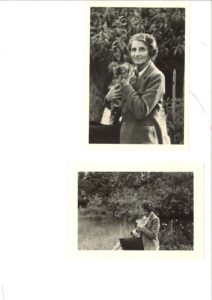The Swiss composer, teacher and conductor Fernande Peyrot was born in Geneva (Swizerland) on November 21st , 1888. She studied at the Geneva Conservatory with Ernst Bloch and with Emile Jaques-Dalcroze, the famous creator of gymnastic and choreographic method for the interpretation of rythm. In 1961 she gained her diploma from “Institut Jaques- Dalcroze”, where she was to teach until her retirement.
In 1919 she left Geneva for Paris, where she studied with André Gédalge and Paul Dukas at the Conservatory. She taught at both the “Ecole de rythmique de Vaugirard” and at the “Ecole normale de musique”. On her return to Geneva, she persued a dual career as teacher and composer, and also directed a small choir for many years.
Peyrot’s work ranges across different genres and includes a large number of choral works and chamber music, several orchestral works and scores for the puppet theatre in Geneva. Her compositions were often played at festivals of the “Association of Swiss musicians”, or by various Geneva-based ensambles. The Swiss-French conductor Ernest Ansermet gave premieres of her “Masse” in 1918 and her “La petite sirène” in 1949.
Fernande Peyrot died in her native Geneva on March 10th , 1978. Her musical archive is kept in the “Fonds Fernande Peyrot” at the Conservatoire de musique in Geneva.
FERNANDE PEYROT AND THE GUITAR
Fernande Peyrot was probably attracted to the guitar by Andrés Segovia, who lived for several years in Geneva and where he gave many concerts. Peyrot was not the only Swiss composer to be inspired by Andrés Segovia. Frank Martin, Volkmar Andreae and Hermann Suter expressed the wish to compose for him. Both “Prélude” by Aloys Fornerod and “Quatre pièces brèves” by Frank Martin were never performed by Segovia.
Prior to the discovery of the “Thème et Variations”, Fernande Peyrot’s known guitar works were a set of four “Prèludes” published in 1986 by Hug & Co. (Zürich), edited by Christoph Jäggin, and a “Petite Suite pour guitare op.31” composed in 1954 and dedicated to the Spanish guitarist José de Azpiazu.
In May 2001, among the papers of the Andrés Segovia Foundation at Linares (Spain), was found the manuscript of a set of four “Préludes”, one of which bears the dedication “para Andrés Segovia”. Two of these four Préludes are identical to those published by Hug with the numbers 1 and 3; another of the Préludes in the Segovia archive appears to be the same as Prélude 4 of the Hug set, but transposed one tone lower; and there is a short Prélude which is missing in the Hug set, whilst Prèlude 2 of the Hug set has not been found in the Segovia archive. We have, than, five Prèludes, of which one is unpublished.
In addition there is “Thème and Variations”, an exellent composition of which the Segovia Archive contains the original manuscript, and which is not included in the Peyrot archive in Geneva. The sole surviving copy of this work is the one given by Fernande Peyrot to Andrés Segovia who preserved it carefully despite never performing it publicly in his recitals. The manuscript is undated, but we believe it was written during Segovia’s residence in Geneva during the 1930s. It seems resonable that a figure such as Fernande Peyrot would estabilish some sort of contact with Andrés Segovia.
Fernande Peyrot’s music is characterised by an extremely intimate expressiveness, without ever
lacking rhythmic precision and detailed dynamics.
In an interview by the journalist Blanche Strubin in “Tribune de Geneve” on 7 April 1962, Fernande Peyrot affirms that the composition is a reckless, unpremeditated act. She cannot, therefore, adhere to the serial technique, to a pre-established system; only when things are done does she realize what she have achieved.
FERNANDE PEYROT AND THE ROLE OF WOMEN IN THE MUSICAL WORLD IN 1960s
In the same interview Fernande Peyrot gives interesting and meaningful insights into her work as a composer and her self-image as a composing, successful woman in a male-dominated sphere.
Fernande Peyrot affirms that composing music implies a total commitment, which leaves no time for private life: a married woman, a mother of a family does not have enough free time, enough freedom of spirit to dedicate herself entirely to her art. There are many married male composers, with families and children, but it is not the same thing.
FERNANDE PEYROT’S GUITAR COMPOSITIONS
“Thème et Variations”
“Petite Suite op. 31” (1954) dedicated to José de Azpiazu
(Berceuse, Marche, Rapsodie, Chanson, Dialogue, Fantaisie)
“4 Preludes” (1986) edited by Christoph Jaggin (Hug & Co. Zurich)
BIBLIOGRAPHY
“Fernande Peyrot” Geneva Fund including:
- – Inventory of the composer’s works
- – Interview by the journalist Blanche Strubin with Fernande Peyrot in “Tribune de Geneve” (Swiss daily newspaper in French published in Geneva since 1879) on 7 April 1962.
- – Biographical article by Fernande Peyrot from the Music Dictionary of Switzerland (updated 06/21/2019)
- – Complete works for guitar: “Thème et Variations” (general editor: Angelo Gilardino, Bèrben),“4 Preludes” and “Petite Suite” (1954) fingered by J. De Azpiazu
© Emma Baiguera, 2024
